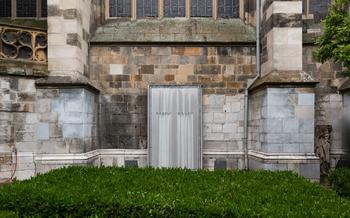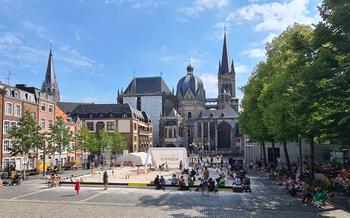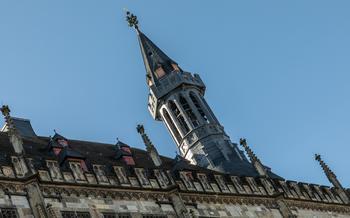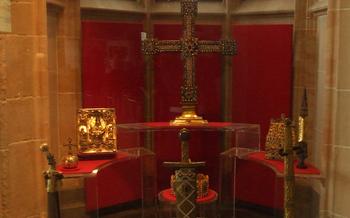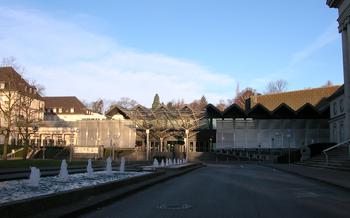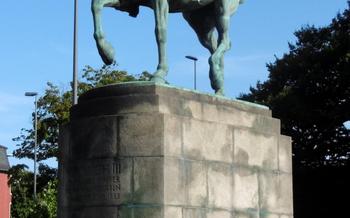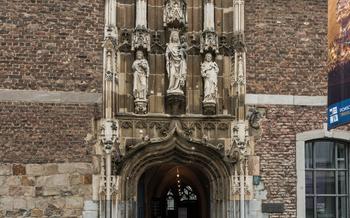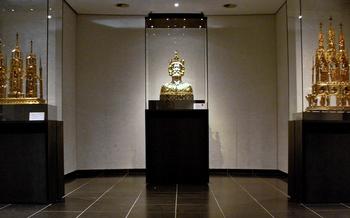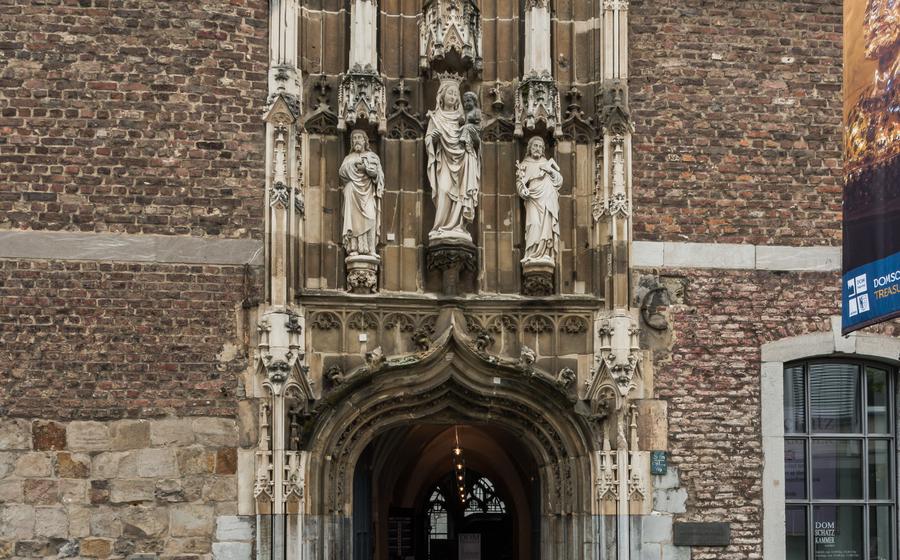
Cathedral Treasury Museum
- Aachen Cathedral Treasury Museum
- Location and Access
- History of the Museum
- Highlights of the Collection
- The Carolingian Renaissance
- Religious Significance of the Collection
- Stories Behind the Artifacts
- Guided Tours and Audio Guides
- Educational Programs and Workshops
- Temporary Exhibitions and Special Events
- Museum Shop and Café
- Accessibility for Disabled Visitors
- Photography and Videography
- Insider Tip: Hidden Gems of the Museum
Aachen Cathedral Treasury Museum
The Aachen Cathedral Treasury Museum is a treasure trove of religious artifacts and masterpieces of medieval art, housed within the historic Aachen Cathedral, a UNESCO World Heritage Site. This museum's unique collection tells the story of the Carolingian Renaissance, a period of cultural and intellectual revival in Europe during the 8th and 9th centuries, and the profound impact of Charlemagne, the first Holy Roman Emperor, on the development of Christianity and Western art.
The museum's collection includes some of the most significant and well-preserved artifacts from the Carolingian period, including the Palatine Cross, a symbol of imperial power; the Reliquary Bust of Charlemagne, a stunning example of goldsmithing; the Codex Aureus of Echternach, a lavishly illuminated manuscript; and the Lothar Cross, a masterpiece of Carolingian jewelry. These artifacts offer a glimpse into the grandeur and opulence of the Carolingian court and the deep religious devotion that characterized this era.
Location and Access
The Aachen Cathedral Treasury Museum is conveniently situated in the heart of Aachen, Germany, within the premises of the Aachen Cathedral, a UNESCO World Heritage Site. The museum's address is Domhof 12, 52062 Aachen. It is easily accessible by foot or public transportation. The nearest train station is Aachen Hauptbahnhof, a 10-minute walk from the museum. Several bus lines also stop nearby.
The museum's opening hours are Tuesday to Sunday from 10:00 AM to 5:00 PM. It is closed on Mondays and major holidays. Admission fees are €6 for adults, €4 for students and seniors, and free for children under Family tickets are also available. The museum is wheelchair accessible, with elevators and ramps throughout the building. Guided tours are available in German and English for an additional fee.
History of the Museum
The Aachen Cathedral Treasury Museum traces its roots back to the Middle Ages, when the church began collecting religious artifacts and treasures. The original purpose of the collection was to preserve and protect these valuable objects, which were often used in religious ceremonies and rituals. Over time, the collection grew to include not only religious artifacts but also works of art, historical documents, and other objects of cultural significance.
In the 19th century, the collection was moved to its current location in the former treasury building of Aachen Cathedral. The museum was officially founded in 1904, and it has since undergone several expansions and renovations to accommodate its growing collection and to improve its accessibility to visitors.
The museum played a crucial role in preserving cultural heritage during World War II. When the cathedral was bombed in 1944, many of the artifacts in the collection were damaged or destroyed. However, the museum staff was able to save many of the most valuable objects by evacuating them to a safe location. After the war, the museum was reconstructed and the collection was restored, allowing visitors to once again appreciate these priceless treasures.
Highlights of the Collection
The Aachen Cathedral Treasury Museum houses a remarkable collection of religious artifacts, many of which are considered masterpieces of medieval art. Among the highlights of the collection are:
- The Palatine Cross: This exquisite cross was commissioned by Emperor Otto III in the 10th century. Made of gold, silver, and precious stones, it is adorned with intricate carvings and enamel work depicting scenes from the life of Christ.
- The Reliquary Bust of Charlemagne: This bust-shaped reliquary contains the skull of Charlemagne, Holy Roman Emperor. Created in the 14th century, it is made of silver and gold and features a lifelike depiction of Charlemagne, complete with a beard and crown.
- The Codex Aureus of Echternach: This illuminated manuscript, dating from the 8th century, is one of the most important surviving examples of Carolingian art. It contains the Gospels, written in gold ink on purple parchment, and is lavishly decorated with intricate miniatures and ornamental borders.
- The Lothar Cross: This cross, dating from the 9th century, is made of gold and silver and is set with precious stones. It was commissioned by Emperor Lothar I and is believed to have been used in his coronation.
The Carolingian Renaissance
The Carolingian Renaissance, also known as the Carolingian Revival, was a period of significant artistic, intellectual, and cultural achievement in Europe during the reign of Charlemagne and his Carolingian dynasty. This period, which lasted from the late 8th to the mid-9th century, was characterized by a revival of classical learning, the promotion of literacy, and the development of a distinctive Carolingian style in art and architecture.
Charlemagne, who ruled from 768 to 814, played a pivotal role in fostering this cultural renaissance. He encouraged the study of Latin and Greek texts, established schools and libraries, and commissioned works of art and architecture that reflected his desire to unite his vast empire and promote Christian values.
Aachen, Charlemagne's chosen capital, became a center of Carolingian art and culture. The city was home to a renowned palace, a school, and a scriptorium where scribes meticulously produced illuminated manuscripts. The Palatine Chapel, built by Charlemagne as part of his palace complex, is a masterpiece of Carolingian architecture and a symbol of the emperor's power and authority.
The Carolingian Renaissance had a profound impact on the development of European culture. It laid the foundation for the later Gothic and Renaissance periods and contributed to the spread of Christianity and literacy throughout Europe. The artistic and intellectual achievements of the Carolingian period continue to be admired and studied today, serving as a testament to the enduring legacy of Charlemagne and his dynasty.
Religious Significance of the Collection
The Aachen Cathedral Treasury Museum houses a collection of religious artifacts that hold immense religious significance for Christians worldwide. Many of these artifacts are associated with important religious figures, such as Charlemagne, the Holy Roman Emperor, and Saint Mary.
The Palatine Cross, for example, is believed to have been commissioned by Charlemagne and was used in religious ceremonies during his reign. The Reliquary Bust of Charlemagne contains relics of the emperor, making it a sacred object for those who venerate him as a saint.
The Codex Aureus of Echternach, a beautifully illuminated manuscript, was created by Benedictine monks in the 10th century and is considered one of the most significant examples of medieval book art. It contains the Gospels, and was used in religious services and processions.
The museum's collection also includes numerous reliquaries, which are containers used to hold the relics of saints and martyrs. These relics were believed to possess miraculous powers and were often used in religious rituals and healing ceremonies.
The religious significance of the Aachen Cathedral Treasury Museum's collection attracts pilgrims and visitors from all over the world who come to see and venerate these sacred objects. The museum plays a crucial role in preserving and showcasing this rich religious heritage, fostering devotion, and providing a tangible connection to the past for believers.
Stories Behind the Artifacts
The Aachen Cathedral Treasury Museum is a treasure trove of stories, both grand and intimate. One of the most famous artifacts, the Palatine Cross, is said to have been commissioned by Charlemagne himself. Legend has it that the cross was created using wood from the True Cross, on which Jesus Christ was crucified.
Another highlight of the collection is the Reliquary Bust of Charlemagne. This magnificent bust was created in the 14th century and depicts the emperor in all his glory. The bust is adorned with precious stones and metals, and it is a testament to the skill of the medieval craftsmen who created it.
The Codex Aureus of Echternach is a lavishly illuminated manuscript that was created in the 11th century. The codex contains the four Gospels and is written in gold and silver ink. It is one of the most valuable manuscripts in the world and is a testament to the cultural and artistic achievements of the Carolingian Renaissance.
These are just a few of the many stories that are waiting to be discovered at the Aachen Cathedral Treasury Museum. Each artifact has its own unique tale to tell, and visitors are invited to explore these stories and learn more about the rich history and culture of Aachen and the Carolingian Empire.
Guided Tours and Audio Guides
The Aachen Cathedral Treasury Museum offers guided tours in various languages, including English, German, French, and Spanish, providing visitors with a deeper understanding of the historical and cultural significance of the collection. These tours are led by knowledgeable and experienced guides who share insights into the stories behind the artifacts, their religious significance, and their role in the Carolingian Renaissance. The cost of guided tours varies depending on the group size and the duration of the tour. Visitors can choose from a range of tour options, including general overviews, themed tours focusing on specific aspects of the collection, and private tours for a more personalized experience. Audio guides are also available for self-guided tours, allowing visitors to explore the museum at their own pace while listening to informative commentary on the exhibits.
Educational Programs and Workshops
The Aachen Cathedral Treasury Museum offers a range of educational programs and workshops designed to engage visitors of all ages and backgrounds. School groups and families can participate in hands-on activities and workshops that bring the history and significance of the collection to life. These programs may include guided tours, treasure hunts, art classes, and interactive storytelling sessions.
The museum also provides educational materials and resources for teachers and parents to use in the classroom or at home. These resources include lesson plans, activity sheets, and online resources that explore the history, art, and religious significance of the collection.
In addition, the museum offers virtual tours and online resources that allow visitors to explore the collection from anywhere in the world. These virtual experiences include 360-degree tours, interactive exhibits, and educational videos that provide insights into the artifacts and their stories.
Temporary Exhibitions and Special Events
The Aachen Cathedral Treasury Museum frequently hosts temporary exhibitions that delve into specific aspects of its collection or explore broader themes related to medieval art and history. These exhibitions provide visitors with the opportunity to see rare and unique artifacts that are not normally on display, as well as to gain insights into the latest research and scholarship in the field.
Past exhibitions have covered topics such as the history of the Aachen Cathedral Treasury, the art of the Carolingian period, and the role of relics in medieval society. Special events, such as concerts, lectures, and workshops, are also held throughout the year, offering visitors the chance to engage with the museum's collection in new and exciting ways.
The museum collaborates with other museums and institutions to organize these exhibitions and events, ensuring a diverse and stimulating program for visitors. Information about upcoming exhibitions and events is available on the museum's website and through social media channels.
Museum Shop and Café
The Aachen Cathedral Treasury Museum offers a well-stocked museum shop where visitors can purchase a variety of souvenirs, books, and replicas of artifacts. The shop is located at the entrance of the museum and offers a wide range of items, including postcards, magnets, jewelry, and religious items.
Visitors can also enjoy a light snack or a refreshing drink at the museum's café, which is located next to the shop. The café offers a selection of sandwiches, pastries, and hot and cold beverages, providing a convenient and relaxing spot for visitors to take a break and reflect on their visit.
The museum shop and café are open during the same hours as the museum itself, and they provide a great opportunity for visitors to extend their experience and take home a piece of the museum's rich history and cultural significance. Whether you're looking for a unique souvenir or simply want to enjoy a break in a beautiful setting, the museum shop and café are worth a visit.
Accessibility for Disabled Visitors
The Aachen Cathedral Treasury Museum is committed to ensuring accessibility for visitors with disabilities. The museum is wheelchair accessible, with elevators and ramps available to access all floors. Adapted tours are offered for visitors with disabilities, providing detailed descriptions and tactile experiences of the artifacts. The museum also provides assistance for visitors with hearing or visual impairments, including sign language interpretation and audio description devices. With these accessibility features, the museum aims to create an inclusive environment where everyone can enjoy and appreciate the treasures of the collection.
Photography and Videography
Photography and videography are permitted in the Aachen Cathedral Treasury Museum, but there are some restrictions to ensure the preservation of the artifacts and the comfort of other visitors. Flash photography and tripods are not allowed, as they can damage the delicate objects on display. For commercial photography or videography, a permit is required from the museum administration. The copyright and usage rights for images and videos taken in the museum belong to the Aachen Cathedral Treasury Museum. Visitors are encouraged to respect these guidelines and to capture their memories of the museum in a responsible and ethical manner.
Insider Tip: Hidden Gems of the Museum
Beyond the well-known masterpieces, the Aachen Cathedral Treasury Museum holds several hidden gems waiting to be discovered. One such treasure is the Byzantine Cross of Lothair, a 10th-century masterpiece adorned with intricate carvings and colorful enamels. The Shrine of the Three Kings, a 12th-century reliquary, is another highlight, showcasing exquisite goldsmith work and depicting the biblical story of the Magi.
Venture into the Secret Chamber, accessible through a hidden door, to marvel at a collection of rare and unusual artifacts, including medieval manuscripts, tapestries, and liturgical vestments. These hidden gems offer a glimpse into the rich history and artistic heritage of the Carolingian era, inviting visitors to delve deeper into the wonders of the Aachen Cathedral Treasury Museum.

